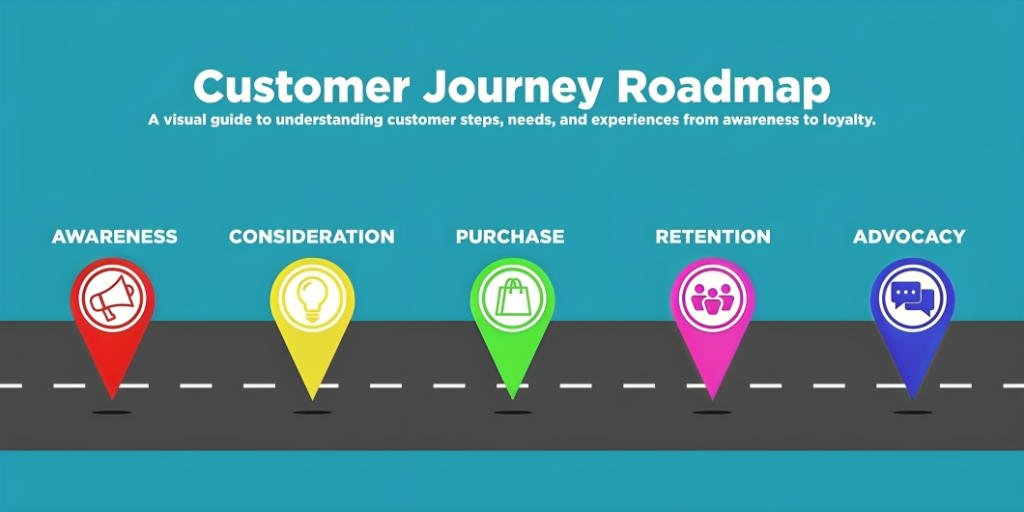The Importance of Product-Market Fit Mapping in SaaS Driving Conversions In the realm of Software as a Service (SaaS), gaining insights into your clientele and their journey through the product is vital in maximizing conversion rates. Customer journey mapping will enable you to depict a customer journey from the initial moment of discovery of the product to becoming a loyal user. This involves mapping a detailed customer journey map that will help you spot the pain points, optimize the touchpoints, and improve conversion. In this blog, we’ll take a look at how you can use customer journey mapping to improve SaaS conversions.
Jump to:
What is Customer Journey Mapping?
Customer journey mapping refers to the visualization of the process that a customer goes through to achieve a goal with your SaaS product. It requires mapping out all of the interactions a customer has with your brand, from first hearing about you to what happens after they buy. A customer journey map focuses on what the customer is experiencing, feeling, and thinking about every stage of their journey. By doing so, you can identify areas where customers may be struggling or losing interest, and make decisions to improve their experience.

Why is Customer Journey Mapping Important for SaaS Conversions?
The customer journey in the SaaS sector is usually labyrinthine, comprising numerous points of contact. Prospects can visit your website and contact you via social media, email campaigns, customer support, and other means before they convert. With no well-documented process for this journey, you will easily lose blind to engage and convert your potential customers. Customer journey mapping enables you to:
Trace the Lifecycle of Customer: Mapping out the customer journey is the first step you can take in understanding how customers use your product and which factors inform their decisions.
Highlight Friction Points: A customer journey map can help identify friction points where customers are dropping off or feeling frustrated, enabling you to address these issues and enhance the overall experience.
TouchPoint Optimization: It is essential to have a clear view of the customer journey so that each touchpoint can be optimized to create a seamless and engaging experience.
Convert More: Mapping out the customer journey allows you to identify pain points and opportunities to optimize touchpoints, resulting in a more compelling journey and higher conversion rates.
How to Create a Customer Journey Map for Your SaaS Product?
Steps Involved in Creating Customer Journey Map for Your SaaS Product Here’s a step-by-step guide to get you started:
1. Who is Your Target Audience?
To map out the customer journey you first have to have a clear understanding of your target audience. Who are your ideal customers? What do they want to achieve, what challenges do they face, and what motivates them? Developing detailed buyer personas can help answer these questions. Buyer personas are semi-fictitious representations of your ideal customer, based on your market research & real data about your existing customers. They can also help you better understand your target audience and create a customer journey map that is aligned with their experience.
2. What are Customer Journey Stages?
The customer journey is typically broken down into several stages, which represent the different phases of a customer’s interaction with your SaaS product. The stages may differ from one business to another, but a common framework consists of:
Awareness: The customer knows about your product or service.
Consideration: The customer considers your product and compares it to others.
Decision: The customer decides to buy your product.
Onboarding: The customer begins utilizing your product and understands how to maximize its utility.
Retention: this is where the customer keeps using your product and becomes a loyal user.
Advocacy: This is when we speak about advocacy the customer recommends your service to someone else.
3. What are the Key Touchpoints in the Customer Journey?
A touchpoint is any interaction your customer has with your brand before, during, or after a purchase contract, such as your website, social media, email, and customer support. It is important to understand the customer touchpoints across all stages of the customer journey. In the awareness stage, touchpoints could be social media ads, blog posts, or webinars, for example. In the consideration stage, touchpoints may include product demos, case studies, or customer reviews. You will see the customer journey by mapping the touchpoints.

4. What are the Goals and Pain Points of the Customer in each Stage?
At every step of the customer journey, customers have some goals, and during that process, they face some pain points that prevent them. In the awareness stage for example, the goal of the customer could be to get more information on your product, but they may be having trouble finding the right information. During the consideration stage, a customer goal may be to compare your product with alternatives yet may struggle to differentiate between them. With these drivers and barriers in mind, you can implement focused enhancements to the customer journey.
5. How Can You Optimize Each Stage of the Customer Journey?
After considering the essential touchpoints, goals, and pain points at every stage of the customer journey, the following step lies in optimizing the experience. This might involve:
How to improve your content: Make sure your website, blog, and social media content is informative, engaging, and relevant to the customer’s needs.
Simplifying Navigation: Improve website navigation and search so that customers can easily locate what they’re looking for.
Improve Onboarding: Offering a smooth onboarding process with guidance, tutorials, and customer support will make it easier to start using your product.
Personalized Communication: Use data to personalize email campaigns, product recommendations, and other communications so that the customer feels valued.
Fixing Pain Points: Find and fix pain points that might make customers drop out or lose interest.
6. How Do You Assess the Performance of Your Customer Journey Map?
To begin, you want to go beyond creating a customer journey map. As a result of this, you require your customer journey map to be quantified to ensure your initial steps are delivering effective results. The most popular approach to facilitate this is by monitoring KPIs like:
Conversion Rates: Are customers converting more at each stage of the journey?
Customer Satisfaction: How satisfied are customers at each of the touchpoints?
Customer Retention Rates: Are your customers repeat purchasers?
Net Promoter Score (NPS): Would customers recommend your product to others?
Monitoring these metrics regularly can help you spot weaknesses and make data-driven decisions to improve the customer journey.
Related Article: https://www.adlabz.co/the-b2b-saas-marketing-metrics-to-track-in-reports
7. How Can You Use Customer Journey Mapping to Improve SaaS Conversions?
So, you’ve created a customer journey map and have optimized every stage of it. Here are some approaches to consider:
Harmonize Marketing/sales efforts: You need to make sure that your marketing/sales teams align and work towards taking the customers through the journey together. This could include data sharing, campaign coordination, and messaging alignment.
Provide Free Trials or Demos: Many SaaS companies provide a free trial or demo of their product so that customers can see the value of the product before they pay. This can be a strong motivator for conversions, particularly during the consideration phase.
Deliver Online Customer Support: Customer support is one of the most vital elements of the customer journey, especially during the onboarding and retention stages. Providing excellent support can instill trust and loyalty in your users, resulting in better conversions and retention.
Leverage Social Proof: Customer reviews, testimonials, and case studies can go a long way in establishing trust and motivating conversions. Be sure to demonstrate social proof at critical touchpoints in the customer journey on your website and through email campaigns, etc.

8. How Can You Continuously Improve Your Customer Journey Map?
Customer journey mapping is a perpetual exercise, as the customer journey evolves with time as the needs, preferences, and behaviors of the customers change. As a result, your customer journey map doesn’t become useless over time; you can easily keep updating it and ensure that it works.
A way to achieve this is to collect customers’ feedback. Collecting feedback regularly helps businesses get insights into their customers’ experience and find the areas that require improvement.
No other steps are as important as data analysis. Analyzing customer behaviors with real-time analytics tools can shed light on trends and patterns that point to opportunities for optimization.
All important to stay on the edge of industry information. Regularly monitoring best practices in customer journey mapping and upcoming trends helps keep your customer journey map relevant and effective.
Lastly, testing and iterating is extremely important. Experimenting with different approaches allows you to find out what works best for your customers. One example, A/B testing can test different versions of a webpage or email campaign to see which version results in more conversions.
9. What are Some Common Mistakes to Avoid When Creating a Customer Journey Map?
Customer journey mapping can be one of the most useful tools for optimizing SaaS conversions, but there are some common pitfalls that you want to avoid:
Not Engaging the Right Stakeholders: Customer journey mapping requires input from multiple teams, including marketing and sales, customer support, and product development. And, if we do not collaborate with the right stakeholders, we can end up with a complex or erroneous map.
Focusing Too Much on the Ideal Journey: Mapping the ideal customer journey is vital, but it’s also essential to understand the actual journey that customers are undertaking. This includes potential detours, potential roadblocks, or even unwarranted behaviors that your customers may undertake.
Not Paying Attention to Customer Emotions: The customer journey is more than just actions and touchpoints, it’s about emotions too. It will help you get a better sense of how your customers feel at each step of the journey so you can create a more empathetic and helpful experience.
Overcomplicating the Map: The objective of a customer journey map is to keep the information presented in it clear and understandable. If there are too many details or unnecessary information on the map, it may become too complicated and may become a thing just to be looked at without deriving any insights and taking action.
10. How Can You Get Started with Customer Journey Mapping Today?
If you’re ready to start lacing together customer journey mapping to improve your SaaS conversions, here’s how to get started.
First, define your goals. Figure out what you want to accomplish with your customer journey map—if you’re looking to increase conversions enhance customer satisfaction or lower churn. Define your objectives clearly to help guide the mapping process.
Next, as the last data point collect data from different sources, provide analytics, and review customer feedback, and sales data. This will also give you a broad overview of the customer journey and the major touchpoints.
Next, make buyer personas that depict your audience. Creating detailed personas will help ensure that your customer journey map accurately reflects the experience of your ideal customers.
Step 3: Map The Customer Journey Once you have the specific data and personas. Map out the customer journey by listing all key touchpoints, goals, and pain points at each stage.
Once you’ve mapped the journey, look for improvement opportunities in the journey. Map the experience you just created and find touchpoints where you can improve customer experience to drive conversion.
Change actions according to your insights. This might include optimizing your website, rethinking your onboarding process, or providing better support or customer service to your users.
Finally, monitor and iterate. Keep a tab on how well your changes are doing and make changes accordingly. Since customer journey mapping is an iterative process it’s important to update and iterate on your map regularly to keep it useful.
Conclusion
One of the most powerful tools to optimize SaaS conversions is customer journey mapping. This enables you to identify customer touch points and goals as well as pain points so that you can create a more streamlined, engaging experience that fosters higher conversion rates. If you’re new to customer journey mapping or are looking to make updates to your existing map, the only way to improve this process is to consistently collect data, analyze customer behavior, and revise how you want to improve based on those data-driven insights. Developing a great customer journey map enables you to lead your customers through every point of their journey and convert them into loyal, long-term users of your SaaS product.
You might also be interested:


